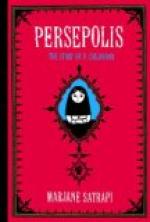Now, because the looking-glass was opposite the window at which Sary Jane did not make vests, and because the rafters sloped, and because the bed lay almost between the looking-glass and the window, the Lady of Shalott was happy. And because, to the patient heart that is a seeker after happiness, “the little more, and how much it is!” (and the little less, what worlds away!) the Lady of Shalott was proud as well as happy. The looking-glass measured in inches 10 X 6. I think that the Lady of Shalott would have experienced rather a touch of mortification than of envy if she had known that there was a mirror in a house just round the corner measuring almost as many feet. But that was one of the advantages of being the Lady of Shalott. She never parsed life in the comparative degree.
I suppose that one must be the Lady of Shalott to understand what comfort there may be in a 10 X 6 inch looking-glass. All the world came for the Lady of Shalott into her looking-glass,—the joy of it, the anguish of it, the hope and fear of it, the health and hurt,—10 X 6 inches of it exactly.
“It is next best to not having been thrown down stairs yourself!” said the Lady of Shalott.
To tell the truth, it sometimes occurred to her that there was a monotony about the world. A garret window like her own, for instance, would fill her sight if she did not tip the glass a little. Children sat in it, and did not play. They made lean faces at her. They were locked in for the day and were hungry. She could not help knowing how hungry they were, and so tipped the glass. Then there was the trap-door in the sidewalk. She became occasionally tired of that trap-door. Seven people lived under the sidewalk; and when they lifted and slammed the trap, coming in and out, they reminded her of something which Sary Jane bought her once, when she was a very little child, at Christmas time,—long ago, when rents were cheaper and flour low. It was a monkey, with whiskers and a calico jacket, who jumped out of a box when the cover was lifted; and then you crushed him down and hasped him in. Sometimes she wished that she had never had that monkey, he was so much like the people coming in and out of the sidewalk.
In fact, there was a monotony about all the people in the Lady of Shalott’s looking-glass. If their faces were not dirty, their hands were. If they had hats, they went without shoes. If they did not sit in the sun with their heads on their knees, they lay in the mud with their heads on a jug.
“Their faces look blue!” she said to Sary Jane.
“No wonder!” snapped Sary Jane.
“Why?” asked the Lady of Shalott.
“Wonder is we ain’t all dead!” barked Sary Jane.
The people in the Lady of Shalott’s glass died, however, sometimes,—often in the summer; more often last summer, when the attic smoked continually, and she mistook Sary Jane’s voice for the rat-trap every day.




